check engine Citroen C4 2014 2.G User Guide
[x] Cancel search | Manufacturer: CITROEN, Model Year: 2014, Model line: C4, Model: Citroen C4 2014 2.GPages: 340, PDF Size: 28.99 MB
Page 97 of 340
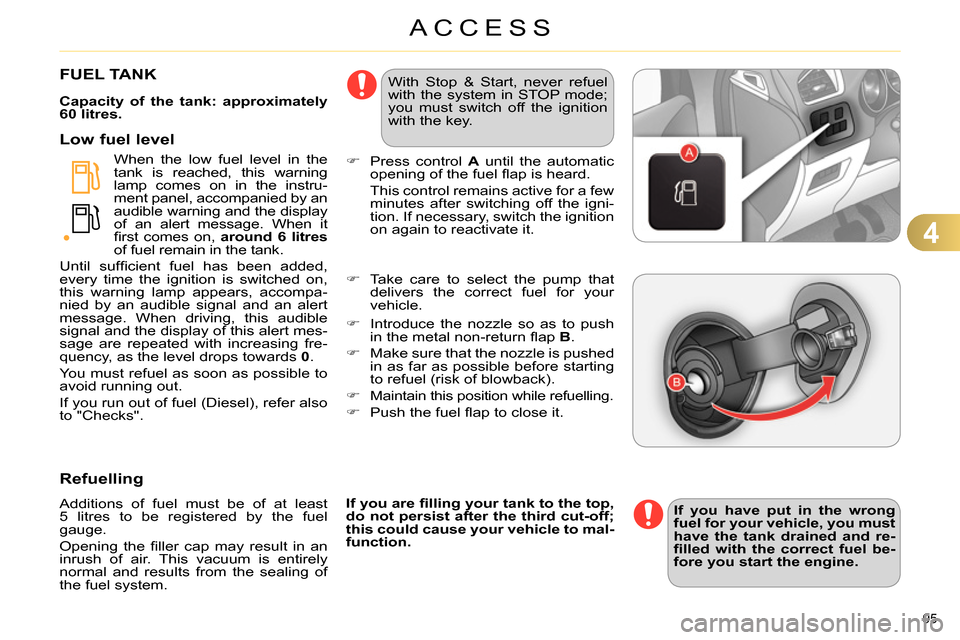
4
ACCESS
95
FUEL TANK
Capacity of the tank: approximately
60 litres.
When the low fuel level in the
tank is reached, this warning
lamp comes on in the instru-
ment panel, accompanied by an
audible warning and the display
of an alert message. When it
fi rst comes on, around 6 litres
of fuel remain in the tank.
Until suffi cient fuel has been added,
every time the ignition is switched on,
this warning lamp appears, accompa-
nied by an audible signal and an alert
message. When driving, this audible
signal and the display of this alert mes-
sage are repeated with increasing fre-
quency, as the level drops towards 0
.
You must refuel as soon as possible to
avoid running out.
If you run out of fuel (Diesel), refer also
to "Checks".
Low fuel level
Refuelling
Additions of fuel must be of at least
5 litres to be registered by the fuel
gauge.
Opening the fi ller cap may result in an
inrush of air. This vacuum is entirely
normal and results from the sealing of
the fuel system.
If you have put in the wrong
fuel for your vehicle, you must
have
the tank drained and re-
fi lled with the correct fuel be-
fore you start the engine.
Press control A
until the automatic
opening of the fuel fl ap is heard.
This control remains active for a few
minutes after switching off the igni-
tion. If necessary, switch the ignition
on again to reactivate it.
If you are fi lling your tank to the top,
do not persist after the third cut-off;
this could cause your vehicle to mal-
function.
Take care to select the pump that
delivers the correct fuel for your
vehicle.
With Stop & Start, never refuel
with the system in STOP mode;
you must switch off the ignition
with the key.
Introduce the nozzle so as to push
in the metal non-return fl ap B.
Make sure that the nozzle is pushed
in as far as possible before starting
to refuel (risk of blowback).
Maintain this position while refuelling.
Push the fuel fl ap to close it.
Page 99 of 340
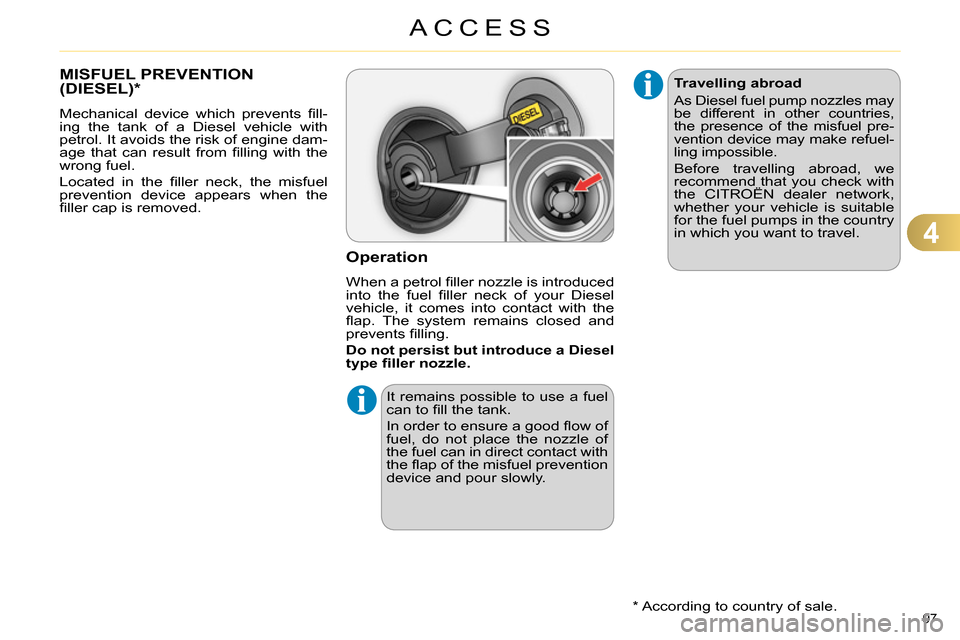
4
ACCESS
97
MISFUEL PREVENTION
(DIESEL) *
Mechanical device which prevents fi ll-
ing the tank of a Diesel vehicle with
petrol. It avoids the risk of engine dam-
age that can result from fi lling with the
wrong fuel.
Located in the fi ller neck, the misfuel
prevention device appears when the
fi ller cap is removed.
Operation
When a petrol fi ller nozzle is introduced
into the fuel fi ller neck of your Diesel
vehicle, it comes into contact with the
fl ap. The system remains closed and
prevents fi lling.
Do not persist but introduce a Diesel
type fi ller nozzle.
It remains possible to use a fuel
can to fi ll the tank.
In order to ensure a good fl ow of
fuel, do not place the nozzle of
the fuel can in direct contact with
the fl ap of the misfuel prevention
device and pour slowly.
* According to country of sale.
Travelling abroad
As Diesel fuel pump nozzles may
be different in other countries,
the presence of the misfuel pre-
vention device may make refuel-
ling impossible.
Before travelling abroad, we
recommend that you check with
the CITROËN dealer network,
whether your vehicle is suitable
for the fuel pumps in the country
in which you want to travel.
Page 110 of 340
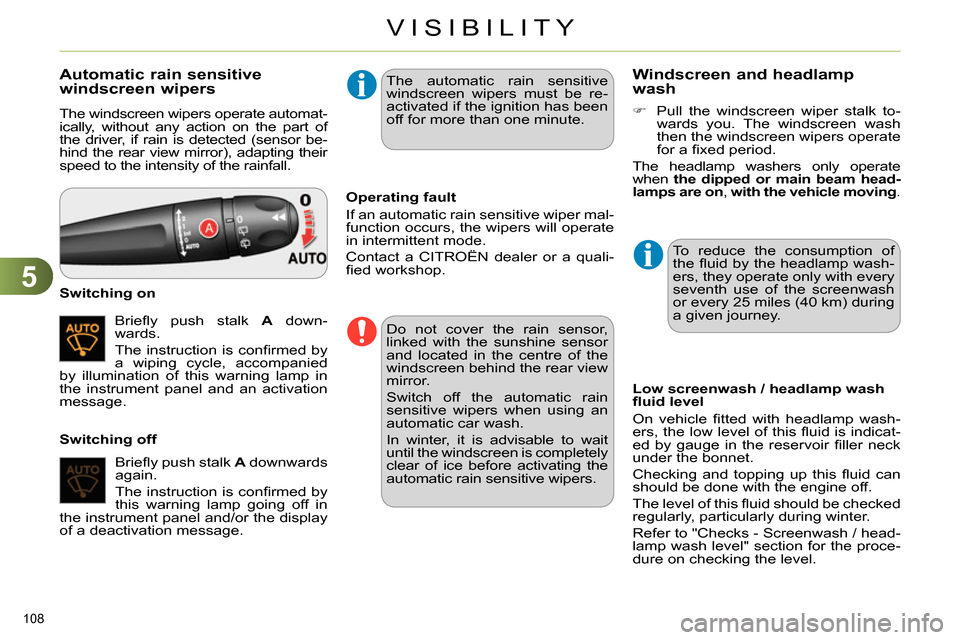
5
VISIBILITY
108
Automatic rain sensitive
windscreen wipers
The windscreen wipers operate automat-
ically, without any action on the part of
the driver, if rain is detected (sensor be-
hind the rear view mirror), adapting their
speed to the intensity of the rainfall.
Briefl y push stalk A
down-
wards.
The instruction is confi rmed by
a wiping cycle, accompanied
by illumination of this warning lamp in
the instrument panel and an activation
message.
Switching on
Switching off
Operating fault
If an automatic rain sensitive wiper mal-
function occurs, the wipers will operate
in intermittent mode.
Contact a CITROËN dealer or a quali-
fi ed workshop.
Do not cover the rain sensor,
linked with the sunshine sensor
and located in the centre of the
windscreen behind the rear view
mirror.
Switch off the automatic rain
sensitive wipers when using an
automatic car wash.
In winter, it is advisable to wait
until the windscreen is completely
clear of ice before activating the
automatic rain sensitive wipers.
The automatic rain sensitive
windscreen wipers must be re-
activated if the ignition has been
off for more than one minute.
Briefl y push stalk A
downwards
again.
The instruction is confi rmed by
this warning lamp going off in
the instrument panel and/or the display
of a deactivation message.
Windscreen and headlamp
wash
Low screenwash / headlamp wash
fl uid level
On vehicle fi tted with headlamp wash-
ers, the low level of this fl uid is indicat-
ed by gauge in the reservoir fi ller neck
under the bonnet.
Checking and topping up this fl uid can
should be done with the engine off.
The level of this fl uid should be checked
regularly, particularly during winter.
Refer to "Checks - Screenwash / head-
lamp wash level" section for the proce-
dure on checking the level.
Pull the windscreen wiper stalk to-
wards you. The windscreen wash
then the windscreen wipers operate
for a fi xed period.
The headlamp washers only operate
when the dipped or main beam head-
lamps are on
, with the vehicle moving
.
To reduce the consumption of
the fl uid by the headlamp wash-
ers, they operate only with every
seventh use of the screenwash
or every 25 miles (40 km) during
a given journey.
Page 120 of 340
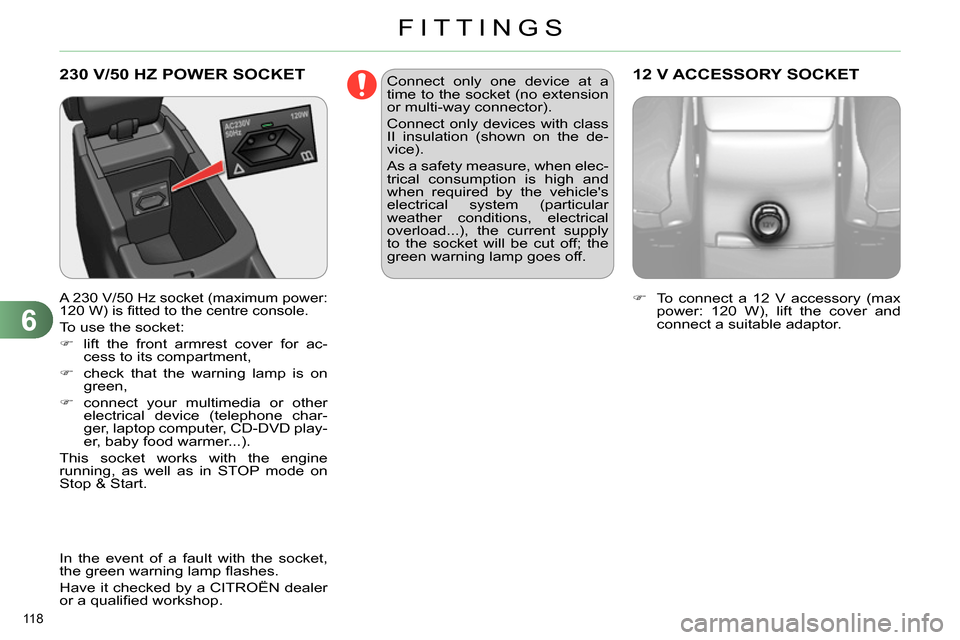
6
FITTINGS
118
230 V/50 HZ POWER SOCKET
A 230 V/50 Hz socket (maximum power:
120 W) is fi tted to the centre console.
To use the socket:
lift the front armrest cover for ac-
cess to its compartment,
check that the warning lamp is on
green,
connect your multimedia or other
electrical device (telephone char-
ger, laptop computer, CD-DVD play-
er, baby food warmer...).
This socket works with the engine
running, as well as in STOP mode on
Stop & Start.
To connect a 12 V accessory (max
power: 120 W), lift the cover and
connect a suitable adaptor.
12 V ACCESSORY SOCKET
Connect only one device at a
time to the socket (no extension
or multi-way connector).
Connect only devices with class
II insulation (shown on the de-
vice).
As a safety measure, when elec-
trical consumption is high and
when required by the vehicle's
electrical system (particular
weather conditions, electrical
overload...), the current supply
to the socket will be cut off; the
green warning lamp goes off.
In the event of a fault with the socket,
the green warning lamp fl ashes.
Have it checked by a CITROËN dealer
or a qualifi ed workshop.
Page 146 of 340
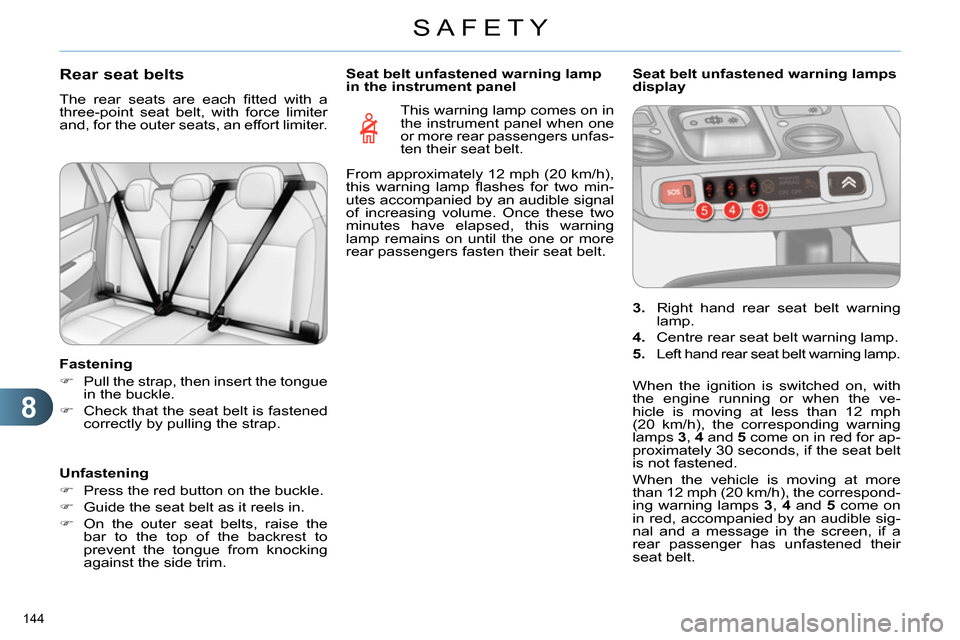
8
SAFETY
144
Rear seat belts
The rear seats are each fi tted with a
three-point seat belt, with force limiter
and, for the outer seats, an effort limiter.
Fastening
Pull the strap, then insert the tongue
in the buckle.
Check that the seat belt is fastened
correctly by pulling the strap.
Unfastening
Press the red button on the buckle.
Guide the seat belt as it reels in.
On the outer seat belts, raise the
bar to the top of the backrest to
prevent the tongue from knocking
against the side trim.
This warning lamp comes on in
the instrument panel when one
or more rear passengers unfas-
ten their seat belt.
Seat belt unfastened warning lamp
in the instrument panel
3.
Right hand rear seat belt warning
lamp.
4.
Centre rear seat belt warning lamp.
5.
Left hand rear seat belt warning lamp.
Seat belt unfastened warning lamps
display
When the ignition is switched on, with
the engine running or when the ve-
hicle is moving at less than 12 mph
(20 km/h), the corresponding warning
lamps 3
, 4
and 5
come on in red for ap-
proximately 30 seconds, if the seat belt
is not fastened.
When the vehicle is moving at more
than 12 mph (20 km/h), the correspond-
ing warning lamps 3
, 4
and 5
come on
in red, accompanied by an audible sig-
nal and a message in the screen, if a
rear passenger has unfastened their
seat belt.
From approximately 12 mph (20 km/h),
this warning lamp fl ashes for two min-
utes accompanied by an audible signal
of increasing volume. Once these two
minutes have elapsed, this warning
lamp remains on until the one or more
rear passengers fasten their seat belt.
Page 158 of 340
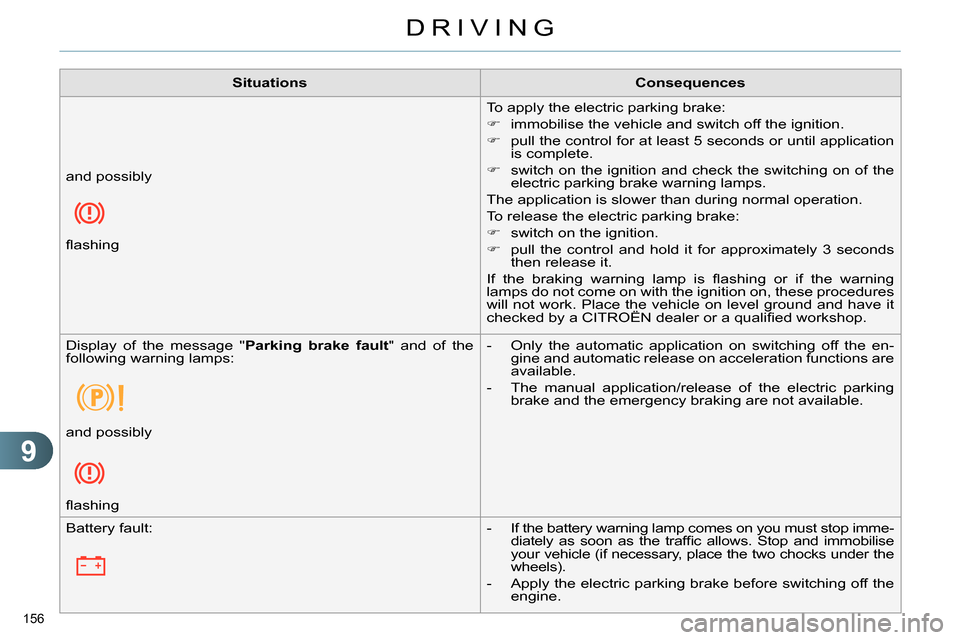
9
DRIVING
156
Situations
Consequences
To apply the electric parking brake:
immobilise the vehicle and switch off the ignition.
pull the control for at least 5 seconds or until application
is complete.
switch on the ignition and check the switching on of the
electric parking brake warning lamps.
The application is slower than during normal operation.
To release the electric parking brake:
switch on the ignition.
pull the control and hold it for approximately 3 seconds
then release it.
If the braking warning lamp is fl ashing or if the warning
lamps do not come on with the ignition on, these procedures
will not work. Place the vehicle on level ground and have it
checked by a CITROËN dealer or a qualifi ed workshop. and possibly
fl ashing
Display of the message " Parking brake fault
" and of the
following warning lamps:
- Only the automatic application on switching off the en-
gine and automatic release on acceleration functions are
available.
- The manual application/release of the electric parking
brake and the emergency braking are not available.
and possibly
fl ashing
Battery fault:
- If the battery warning lamp comes on you must stop imme-
diately as soon as the traffi c allows. Stop and immobilise
your vehicle (if necessary, place the two chocks under the
wheels).
- Apply the electric parking brake before switching off the
engine.
Page 162 of 340

9
DRIVING
160
You can change mode at any
time by moving the gear lever
from A
to M
or the other way
round.
At low high speed, if reverse gear is
requested, the N
indicator fl ashes and
the gearbox goes into neutral automati-
cally. To engage reverse, put the gear
lever in position N
, then position R
.
When immobilising the vehicle,
with the engine running, you
must place the gear lever in neu-
tral N
.
Before carrying out any work in
the engine compartment, ensure
that the gear lever is in neutral N
and that the parking brake is ap-
plied.
Whatever the circumstances,
you must manually apply the
parking brake when parking,
unless the parking brake is pro-
grammed in automatic mode.
Reverse
To engage reverse gear R
, the vehicle
must be immobilised with your foot on
the brake pedal.
Select position R
.
Operating fault
With the ignition on, the fl ashing of
AUTO
, accompanied by an audible sig-
nal and a message in the screen, indi-
cates a malfunction of the gearbox.
Have it checked by a CITROËN dealer
or a qualifi ed workshop.
Manual mode
Select position M
.
The gears engaged appear in
succession in the instrument
panel screen.
The gear change requests are only act-
ed on if the engine speed permits.
It is not necessary to release the accel-
erator during gear changes.
When braking or slowing down, the
gearbox changes down automatically
to allow the vehicle to accelerate in the
correct gear.
On sharp acceleration, the gearbox will
not change up unless the driver acts on
the gear lever or the steering mounted
paddles.
Temporary control of gear changing
You can temporarily take over control
of gear changing using the "+"
and "-"
steering mounted paddles: if the engine
speed allows, the request to change
gear is acted on.
This function allows you to anticipate
certain situations such as overtaking a
vehicle or the approach to a corner.
After a few moments without any action
on the control paddles, the gearbox re-
sumes automatic control of the gears.
Never select neutral N
while the
vehicle is moving.
Stopping the vehicle
Before switching off the engine, you
can:
- move to position N
to engage neutral,
or
- leave the gear engaged; in this
case, it will not be possible to move
the vehicle.
In both cases, you must apply the
parking brake
to immobilise the vehicle.
Page 165 of 340
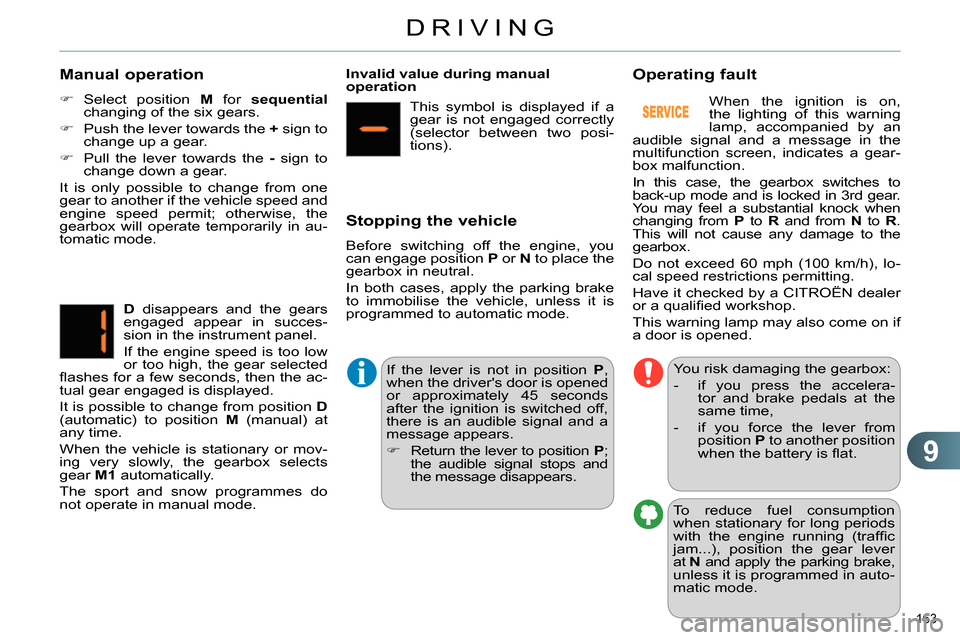
9
DRIVING
163
Manual operation
Select position M
for sequential
changing of the six gears.
Push the lever towards the +
sign to
change up a gear.
Pull the lever towards the -
sign to
change down a gear.
It is only possible to change from one
gear to another if the vehicle speed and
engine speed permit; otherwise, the
gearbox will operate temporarily in au-
tomatic mode.
D
disappears and the gears
engaged appear in succes-
sion in the instrument panel.
If the engine speed is too low
or too high, the gear selected
fl ashes for a few seconds, then the ac-
tual gear engaged is displayed.
It is possible to change from position D
(automatic) to position M
(manual) at
any time.
When the vehicle is stationary or mov-
ing very slowly, the gearbox selects
gear M1
automatically.
The sport and snow programmes do
not operate in manual mode.
Invalid value during manual
operation
This symbol is displayed if a
gear is not engaged correctly
(selector between two posi-
tions).
Stopping the vehicle
Before switching off the engine, you
can engage position P
or N
to place the
gearbox in neutral.
In both cases, apply the parking brake
to immobilise the vehicle, unless it is
programmed to automatic mode.
If the lever is not in position P
,
when the driver's door is opened
or approximately 45 seconds
after the ignition is switched off,
there is an audible signal and a
message appears.
Return the lever to position P
;
the audible signal stops and
the message disappears.
You risk damaging the gearbox:
- if you press the accelera-
tor and brake pedals at the
same time,
- if you force the lever from
position P
to another position
when the battery is fl at. When the ignition is on,
the lighting of this warning
lamp, accompanied by an
audible signal and a message in the
multifunction screen, indicates a gear-
box malfunction.
In this case, the gearbox switches to
back-up mode and is locked in 3rd gear.
You may feel a substantial knock when
changing from P
to R
and from N
to R
.
This will not cause any damage to the
gearbox.
Do not exceed 60 mph (100 km/h), lo-
cal speed restrictions permitting.
Have it checked by a CITROËN dealer
or a qualifi ed workshop.
This warning lamp may also come on if
a door is opened.
Operating fault
To reduce fuel consumption
when stationary for long periods
with the engine running (traffi c
jam...), position the gear lever
at N
and apply the parking brake,
unless it is programmed in auto-
matic mode.
Page 166 of 340
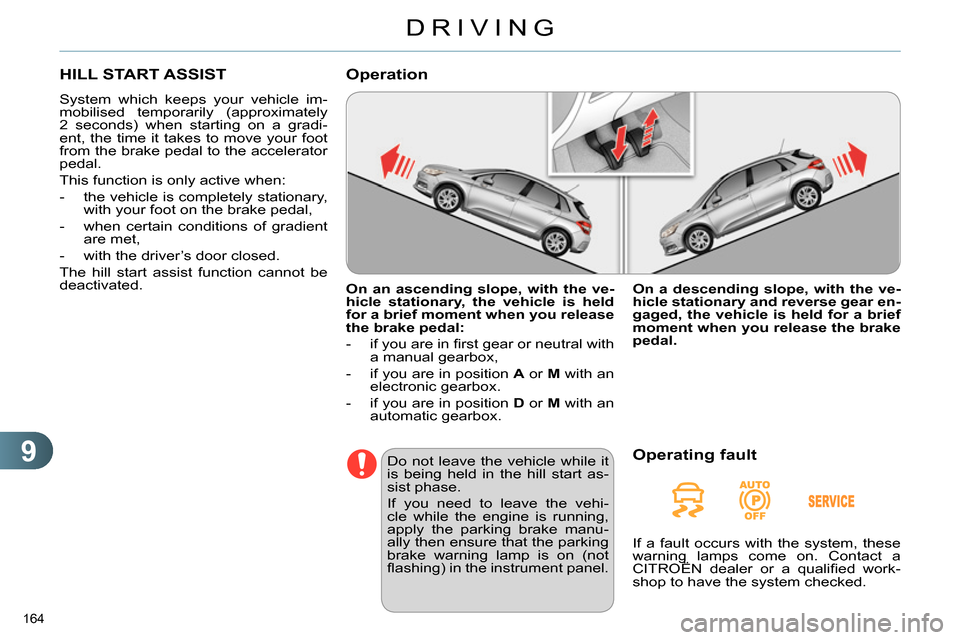
9
DRIVING
164
HILL START ASSIST
System which keeps your vehicle im-
mobilised temporarily (approximately
2 seconds) when starting on a gradi-
ent, the time it takes to move your foot
from the brake pedal to the accelerator
pedal.
This function is only active when:
- the vehicle is completely stationary,
with your foot on the brake pedal,
- when certain conditions of gradient
are met,
- with the driver’s door closed.
The hill start assist function cannot be
deactivated.
On an ascending slope, with the ve-
hicle stationary, the vehicle is held
for a brief moment when you release
the brake pedal:
- if you are in fi rst gear or neutral with
a manual gearbox,
- if you are in position A
or M
with an
electronic gearbox.
- if you are in position D
or M
with an
automatic gearbox.
Operation
Do not leave the vehicle while it
is being held in the hill start as-
sist phase.
If you need to leave the vehi-
cle while the engine is running,
apply the parking brake manu-
ally then ensure that the parking
brake warning lamp is on (not
fl ashing) in the instrument panel.
On a descending slope, with the ve-
hicle stationary and reverse gear en-
gaged, the vehicle is held for a brief
moment when you release the brake
pedal.
Operating fault
If a fault occurs with the system, these
warning lamps come on. Contact a
CITROËN dealer or a qualifi ed work-
shop to have the system checked.
Page 186 of 340
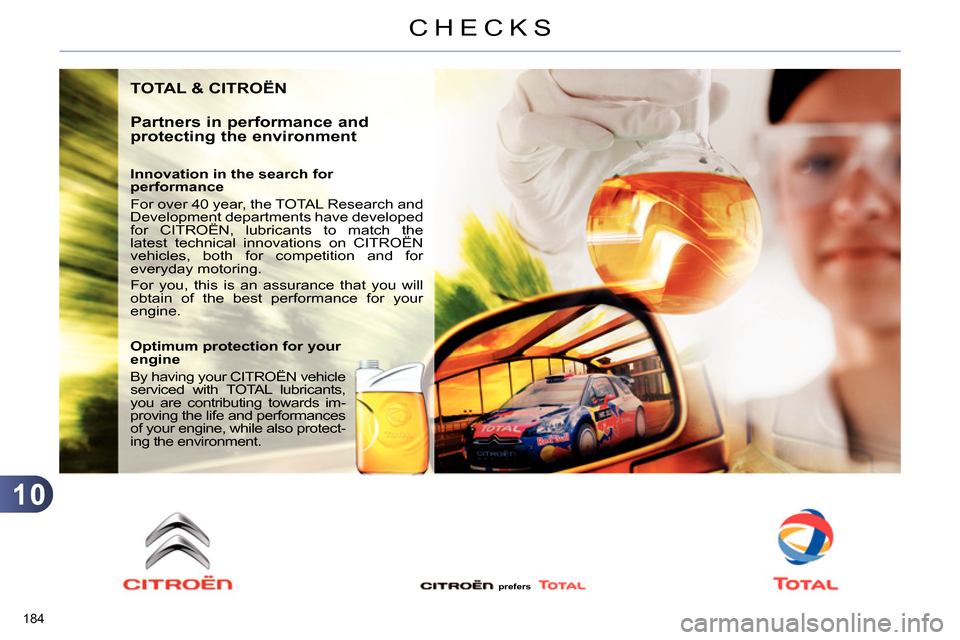
10
CHECKS
184
TOTAL & CITROËN
Partners in performance and
protecting the environment
Innovation in the search for
performance
For over 40 year, the TOTAL Research and
Development departments have developed
for CITROËN, lubricants to match the
latest technical innovations on CITROËN
vehicles, both for competition and for
everyday motoring.
For you, this is an assurance that you will
obtain of the best performance for your
engine.
Optimum protection for your
engine
By having your CITROËN vehicle
serviced with TOTAL lubricants,
you are contributing towards im-
proving the life and performances
of your engine, while also protect-
ing the environment.
prefers